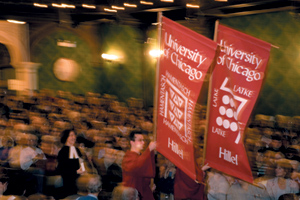|
||
      |
Editor's Notes:
Praise the lard

Banner night for carbohydrates: the latke takes on the hamantash in Mandel
Hall.
To everything there is a season. When it’s almost winter in Chicago, it’s time for an academic food fight.
If you don’t know from latke (or hamantash), don’t look for an answer here. Read a book. Better yet, as was pointed out several times during the annual Latke-Hamantash Debate, buy the book (The Great Latke-Hamantash Debate, University of Chicago Press, 2005).
The 60th incarnation of the Hillel event, held as always on the Tuesday before Thanksgiving, honored the traditions: mock academic procession, snarky introductions by U of C philosophy professor Ted Cohen, AB’62, and musical entertainment. At debate’s end, the attendees moved to Hutchinson Commons to vote their appetites.
But, as is also traditional, there were fresh twists. The student a cappella group Chicago Rhythm and Jews startled the crowd by bursting into the opening bars of “Silent Night,” then reverted to repertoire. Marianna Tax Choldin, AB’62, AM’67, PhD’79—daughter of debate cofounder and U of C anthropologist Sol Tax, PhD’35—recalled how her father “invented the Food Channel,” accompanying his pro-latke lectures with latke-making demonstrations. And Daniel J. Libenson, executive director of the Newberger Hillel Center, called for “original scholarly work relating to the superiority of latkes, hamantashen, or other Jewish food” for possible publication in the inaugural issue of the Journal of Latke and Hamantash Studies; manuscripts and ideas for consideration are due February 14, 2007.
Psychiatry professor Elliot Gershon took the long view of the primal and primate conflict, going back to the Olduvai Gorge (aka the Garden of Eden) and a series of clashes between the chimps (projectile weapon of choice: hamantash) and humans (latke). Meanwhile Assistant Professor of Philosophy Yitzhak Melamed resorted to pure, if convoluted, reason to prove a) there are no equilateral triangles; b) therefore there are no triangles; and c) therefore there are no hamantashen. End of argument.
You should live so long. Rockefeller Chapel Dean Alison Boden, channeling a small-town pastor who was part Church Lady, part televangelist, carried the hamantash banner by going straight to the primary source: “The Bible is the Word of God. It says so.” The New World potato doesn’t appear in those pages, she pointed out, but Haman does. Recapping the story of Esther and Mordecai’s victory over the villainous vizier, Boden took time for a cautionary aside, prompted by the breakup of the King of Persia and Esther’s predecessor, Vashti: “Ladies, if your husband wants you to take off your clothes and dance for his pals, it’s time to rethink the relationship.”
Then it was back to praising the Purim “cookie” and urging the crowd to join the hamantash in the amen corner: “Do I have a witness?” She did.